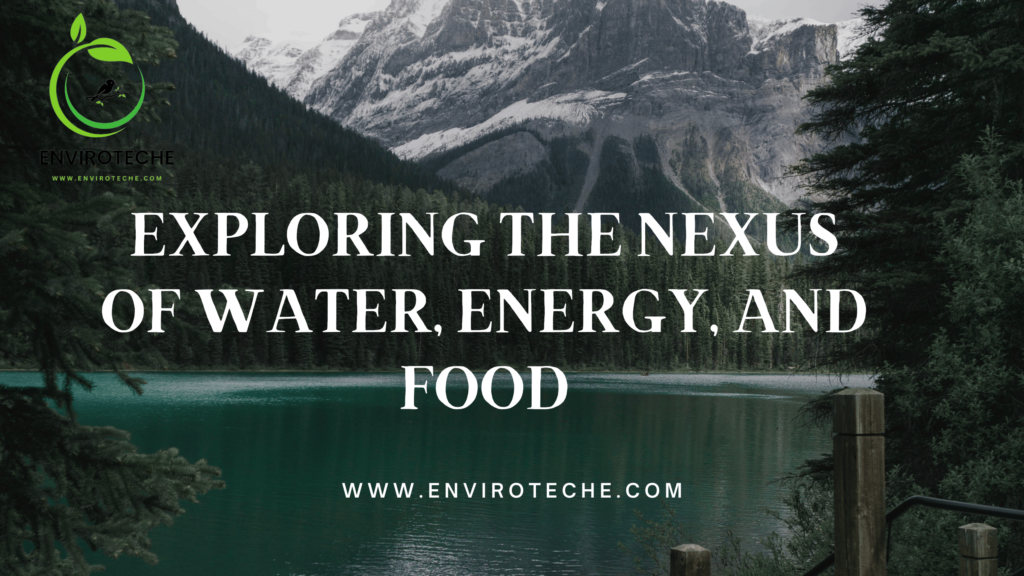
Muhammad Qasim1, Irfan Haidri1
1Department of Environmental Sciences, Government College University Faisalabad
Introduction:
Understanding and taking into account how the systems of water, energy, and food are interrelated is essential in our pursuit of sustainable development. These three industries are not separate entities but rather are intricately interconnected, with decisions and actions in one industry having an effect on the others. In order to maintain long-term sustainability.
This blog post attempts to examine the relationship between water, energy, and food and to emphasize the significance of integrated approaches.
The Nexus of Water, Energy, and Food
Water-Energy Nexus:
Hydropower, thermal power plants, and cooling procedures all depend on H2O for their operations. On the other hand, water extraction, purification, distribution, and wastewater management all demand energy. In order to maintain their sustainable usage and prevent trade-offs between the two sectors, H2O and energy needs must be balanced.
Water-Food Nexus:
A sizable amount of the world’s H2O usage is consumed by agriculture. Water availability has a direct impact on crop yields and agricultural productivity, therefore irrigation systems are crucial for food production. To meet the rising food demand while reducing H2O scarcity and environmental damage, efficient H2O management in agriculture is essential.
Energy-Food Nexus:
Food production, processing, transportation, and storage all depend heavily on energy. The energy inputs used in agriculture, such as fossil fuels, electricity, and mechanization, are heavily reliant. On the other hand, food production and consumption add to issues with energy, such as greenhouse gas emissions and the need for transportation fuels.
Challenges and Risks:
Water Scarcity: Water shortage has been a problem in many areas due to population growth, climate change, and ineffective water management techniques. Water scarcity has an impact on energy production, food processing, and agriculture. Water, energy, and food nexuses must be taken into account in integrated ways to address water scarcity.
Energy Security: For sustainable H2O management and agricultural production, energy sources must be accessible and affordable. Energy security is jeopardized by reliance on fossil fuels and centralized energy infrastructure. Energy security can be improved while fostering sustainable food and H2O systems through the diversification of energy sources, the promotion of renewable energy, and decentralized energy systems.
Climate Change: Water, energy, and food are all interdependent, and climate change makes these links worse. The productivity of agriculture, the availability of H2O, and the production of energy are all hampered by rising temperatures, shifting precipitation patterns, and extreme weather events. Building resilience and lowering carbon footprints in all three sectors require adaptation and mitigation methods.
Climate Change Impacts: The problems associated with the water-energy-food nexus are made worse by climate change. Adaptive methods are required because of the effects that climate change, shifting precipitation patterns, and extreme weather events have on energy production, agricultural productivity, and water availability.
Integrated Approaches for Sustainability:
Policy Integration: Governments and other institutions must implement comprehensive policies that take into account how H2O, energy, and food are interconnected. Resource optimization and the promotion of sustainable practices can be achieved with the use of integrated resource planning, regulation, and price mechanisms.
Technological Innovations: In order to address nexus concerns, creative technology development and deployment are essential. Sustainable resource management is facilitated by developments in H2O-efficient irrigation, renewable energy sources, precision agriculture, and smart grid technologies.
Cross-Sectoral Collaboration: Collaboration between many stakeholders, such as governments, corporations, academic institutions, and civil society, is essential. In order to effectively handle nexus concerns, collaborative activities can improve knowledge exchange, allow coordinated action, and utilize pooled expertise.
Sustainable Solutions:
Water-Energy-Food Nexus Assessments: The dynamics of the nexus can be better understood and appropriate treatments can be found by conducting thorough analyses. These evaluations examine resource consumption, point out trade-offs, and assist in decision-making.
Integrated Water-Energy-Food Projects: More sustainable results may result from the implementation of initiatives that take into account how intertwined the food, energy, and H2O systems are. Examples include circular economy strategies, sustainable agricultural methods, and integrated water and energy infrastructure.
Education and Awareness: In order to encourage sustainable behaviors and well-informed decision-making, it is crucial to promote knowledge of and education about the nexus idea. Knowledge-based empowerment of people, communities, and policymakers can promote positive change and promote responsible resource management.
Conclusion:
The interdependencies between H2O, energy, and food must be addressed if sustainable development is to be achieved. We can successfully manage the issues within the H2O-energy-food nexus by taking an integrated strategy, taking policy coherence and technical breakthroughs into account, and encouraging collaboration. A resilient and successful future for everybody depends on sustainable solutions and group effort. Let’s make an effort to embrace this nexus and progress toward a world that is sustainable and interdependent.
Check Other Schlorships:

